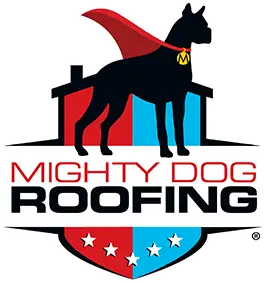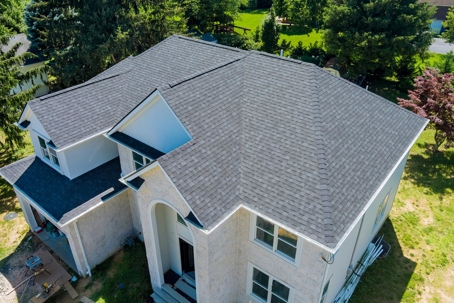Your home’s roof is its first line of defense against the elements, and in Connecticut, that means enduring snowy winters, humid summers, and unpredictable storms. Choosing the right roofing materials and understanding how the region’s climate impacts longevity is crucial for maintaining a durable, energy-efficient, and weather-resistant roof.
In this blog, we’ll explore the best roofing choices for New England climates, how humidity affects roof longevity, and choosing the right roofing material for snowy areas.
Best Roofing Choices for New England Climates
New England’s climate is diverse, with cold, snowy winters, hot, humid summers, and occasional hurricanes. Because of these conditions, Connecticut homeowners need a roof that can withstand temperature fluctuations, moisture exposure, and heavy snowfall.
Here are the best roofing materials for Connecticut and other New England states:
1. Asphalt Shingles (Best for Cost and Durability)
- Most popular roofing material in New England
- Affordable, easy to install, and comes in a variety of colors
- Impact-resistant options available for better durability
- Lifespan: 20-30 years
Best for: Homeowners looking for a cost-effective roofing solution with good durability and aesthetic appeal.
2. Metal Roofing (Best for Snow and Storm Resistance)
- Excellent durability against heavy snow and high winds
- Energy-efficient, reflecting heat in summer and preventing heat loss in winter
- Resistant to fire, mold, and rot
- Lifespan: 40-70 years
Best for: Homeowners who want a long-lasting, energy-efficient, and snow-resistant roof.
3. Slate Roofing (Best for Historic and High-End Homes)
- Extremely durable and resistant to extreme weather
- Adds classic New England charm and elegance
- Fireproof, mold-resistant, and low maintenance
- Lifespan: 50-100 years
Best for: Homeowners looking for a luxury, long-lasting roofing option, especially in historic areas of Connecticut.
4. Cedar Shake Roofing (Best for Traditional Aesthetic and Insulation)
- Natural insulation helps regulate indoor temperatures
- Rustic, classic New England appearance
- Requires proper maintenance to prevent mold and rot
- Lifespan: 30-40 years
Best for: Homeowners who want a natural, traditional aesthetic but are willing to maintain the roof to prevent water damage.
5. Synthetic Roofing (Best for Low Maintenance and Longevity)
- Designed to mimic slate, wood, or tile, but with enhanced durability
- Resistant to moisture, mold, and cracking
- Lower maintenance than natural materials
- Lifespan: 40-50 years
Best for: Homeowners looking for low-maintenance, durable roofing that mimics high-end materials.
How Humidity Affects Roof Longevity
Connecticut homeowners often deal with high humidity levels, particularly in summer. Excess moisture can lead to roofing issues like mold, mildew, and premature aging.
Here’s how humidity impacts your roof and how to prevent damage:
1. Mold and Algae Growth
Problem: Humidity encourages mold and algae to grow on shingles, leading to black streaks and weakened roofing materials.
Solution: Choose algae-resistant asphalt shingles or metal roofing, and clean your roof regularly.
2. Wood Rot and Warping
Problem: Wooden roofing materials, like cedar shakes, absorb moisture and can rot or warp over time.
Solution: Ensure proper ventilation in your attic to reduce trapped moisture. Use treated wood for added protection.
3. Shingle Deterioration
Problem: Constant moisture exposure can soften and break down asphalt shingles, leading to cracks and leaks.
Solution: Invest in high-quality, moisture-resistant shingles, and inspect your roof for early signs of deterioration.
4. Poor Roof Ventilation
Problem: Without proper ventilation, humid air gets trapped in the attic, raising indoor temperatures and increasing mold risk.
Solution: Install ridge vents, soffit vents, or attic fans to regulate airflow and moisture levels.
Key Takeaway: If you live in humid areas of Connecticut, choose moisture-resistant materials, maintain good ventilation, and schedule regular inspections to extend your roof’s lifespan.
Choosing the Right Roofing Material for Snowy Areas
Connecticut sees heavy snowfall in winter, which can put extra weight on your roof, leading to ice dams, leaks, and structural stress. Choosing the right roofing material helps prevent winter-related damage.
1. Metal Roofing (Best for Shedding Snow Quickly)
- Snow slides off easily, preventing excessive weight buildup
- Resistant to ice dams due to its smooth surface
- Great durability in extreme cold temperatures
Ideal for: Homes in snow-prone areas where heavy accumulation is a concern.
2. Asphalt Shingles (Best for Affordability in Snowy Climates)
- Works well in snowy conditions with proper insulation
- Can absorb some heat, helping snow melt naturally
- Reinforced asphalt shingles provide better resistance to freezing temperatures
Ideal for: Homeowners on a budget who still want solid protection against snow.
3. Slate Roofing (Best for Heavy-Duty Snow Protection)
- Extremely durable under heavy snow loads
- Fireproof and water-resistant, preventing leaks and ice damage
- Very long lifespan with minimal maintenance
Ideal for: High-end homes or historic properties looking for long-term roofing solutions in snowy regions.
4. Synthetic Roofing (Best for Lightweight Snow Protection)
- Durable but lighter than natural slate, reducing structural stress
- Moisture and freeze-resistant, preventing ice-related cracking
- Long-lasting alternative to traditional materials
Ideal for: Homeowners wanting a balance between durability, style, and weight reduction.
Final Thoughts: Connecticut Homeowners Need to Consider Regional Roofing Considerations
Choosing the right roofing material for Connecticut’s unique climate can significantly impact your home’s durability, energy efficiency, and maintenance needs.
Key Takeaways:
- For overall durability – Metal, slate, and synthetic roofing are excellent choices.
- For humid areas – Proper ventilation and mold-resistant materials are essential.
- For snowy climates – Metal and slate roofing are ideal for shedding snow quickly.
- For affordability – Asphalt shingles provide good protection at a lower cost.
By considering Connecticut’s seasonal weather patterns and choosing the best roofing material for your specific location, homeowners can enjoy a long-lasting, high-performing roof that enhances curb appeal and energy efficiency.
If you’re unsure which roofing option is best for your home, consult with a professional Connecticut roofing contractor to ensure you make the right investment.


